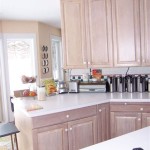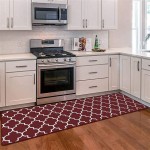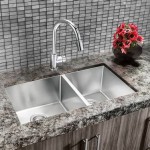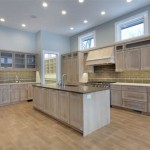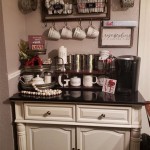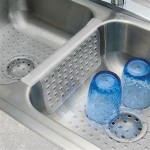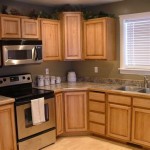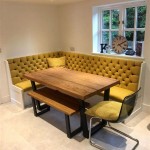Kitchen Decor Ideas: A Visual Guide to Inspiring Spaces
The kitchen stands as the heart of the home, a space for culinary creation, social gathering, and daily sustenance. Its decor plays a crucial role in establishing the atmosphere, functionality, and overall aesthetic appeal. This article explores a variety of kitchen decor ideas, presented visually through descriptive imagery, to inspire homeowners in shaping their ideal cooking haven.
The following ideas encompass a range of styles, from contemporary minimalism to rustic charm, catering to diverse preferences and spatial constraints. Considerations for color palettes, material selection, lighting design, and storage solutions are addressed to provide a comprehensive overview of kitchen decor possibilities.
Maximizing Space with Clever Storage Solutions
Effective storage is paramount in any kitchen design, particularly in smaller spaces. A well-organized kitchen reduces clutter, streamlines workflow, and enhances the overall visual appeal. Built-in cabinetry is a classic solution, offering ample storage while seamlessly integrating into the kitchen’s design. Consider incorporating pull-out shelves, drawer dividers, and spice racks to maximize the utility of cabinet space.
Open shelving provides an alternative approach to storage, allowing for the display of frequently used items, decorative objects, and cookbooks. The visual accessibility offered by open shelving can make a kitchen feel more open and inviting. However, it requires diligent organization and regular cleaning to maintain a tidy appearance. Strategically placed baskets and containers can help conceal clutter and maintain a cohesive aesthetic.
Vertical storage solutions, such as pot racks and wall-mounted utensil holders, are particularly beneficial in kitchens with limited counter space. These solutions free up valuable work surfaces while keeping essential tools within easy reach. Innovative storage ideas can extend beyond traditional cabinetry. For example, incorporating drawers within the kitchen island or utilizing the space beneath the sink can add significant storage capacity.
Consider the placement of storage in relation to work zones. Strategically located storage for food preparation, cooking, and cleaning supplies can significantly improve the efficiency of kitchen tasks. For instance, storing spices near the cooktop or utensils near the preparation area can streamline the cooking process. The overall goal is to create a storage system that is both functional and aesthetically pleasing, contributing to a well-organized and visually harmonious kitchen.
A well-placed pantry is excellent for dry goods and bulk items. Sliding shelves and adjustable shelving within the pantry can help maximize storage and accommodate varying items. If space is limited, a narrow, pull-out pantry can be cleverly integrated into the design. Consider the materials used for storage; opting for transparent containers or labeled bins can improve visibility and accessibility.
Elevating Aesthetics with Color and Material Choices
The color palette and material selection are fundamental elements in defining the aesthetic of a kitchen. The choice of colors can significantly impact the perceived size, mood, and overall character of the space. Light and neutral colors, such as white, cream, and gray, are popular choices for creating a bright and airy atmosphere. These colors reflect light effectively, making the kitchen feel more spacious and inviting.
Bold and vibrant colors can add personality and energy to the kitchen. Accent walls, colorful cabinetry, or patterned backsplashes can serve as focal points, injecting visual interest into the space. However, it is important to use bold colors judiciously to avoid overwhelming the overall design. Consider the natural lighting in the kitchen when selecting colors; darker shades may appear even darker in dimly lit spaces.
Material choices play a critical role in both the aesthetic and functional aspects of the kitchen. Countertops are a prominent feature, requiring durability, ease of maintenance, and visual appeal. Granite, quartz, marble, and concrete are popular countertop materials, each offering unique characteristics. Granite provides a natural, textured look, while quartz offers a more uniform and durable surface. Marble exudes luxury, but it requires more careful maintenance. Concrete offers a modern, industrial aesthetic.
Cabinetry materials also contribute significantly to the kitchen’s overall look. Wood cabinets offer warmth and character, available in a variety of finishes and styles. Painted cabinets provide a cleaner, more contemporary look, allowing for greater flexibility in color selection. Laminate cabinets are a more affordable option, offering a wide range of designs and finishes. Consider the hardware used on cabinets and drawers; knobs and pulls can significantly impact the style and feel of the kitchen.
Backsplashes offer an opportunity to add texture, color, and pattern to the kitchen. Tile is a common backsplash material, available in a vast array of shapes, sizes, and colors. Glass tiles provide a sleek and modern look, while ceramic tiles offer a more traditional aesthetic. Stone backsplashes add a natural, rustic touch. Consider the grout color used with the backsplash; it can significantly impact the overall appearance. A contrasting grout color can highlight the pattern of the tiles, while a matching grout color can create a more seamless look.
Flooring materials should also complement the overall design. Hardwood flooring adds warmth and character, while tile provides durability and water resistance. Laminate flooring offers a cost-effective alternative to hardwood, mimicking the look of wood or stone. Consider the pattern and texture of the flooring; a herringbone pattern can add visual interest, while a textured surface can provide better traction.
Enhancing Ambiance with Lighting Design
Lighting is a crucial aspect of kitchen decor, influencing both the functionality and the ambiance of the space. A well-designed lighting scheme should incorporate a combination of ambient, task, and accent lighting to create a balanced and visually appealing environment. Ambient lighting provides general illumination, filling the kitchen with soft and even light. Recessed lighting, chandeliers, and pendant lights can be used to create ambient lighting.
Task lighting focuses on illuminating specific work areas, such as countertops, cooktops, and sinks. Under-cabinet lighting is an essential task lighting solution, providing focused illumination for food preparation. Pendant lights over the kitchen island or breakfast bar can also serve as task lighting, providing direct illumination for these areas. Ensure that task lighting is bright and focused, minimizing shadows and glare.
Accent lighting is used to highlight specific features of the kitchen, such as artwork, decorative objects, or architectural details. Track lighting, spotlights, and wall sconces can be used to create accent lighting. Consider the placement and direction of accent lighting to effectively showcase the desired features. Dimmable lighting allows for adjustable brightness levels, creating different moods and atmospheres within the kitchen.
Natural light is a valuable asset in any kitchen. Maximize natural light by keeping windows clean and free of obstructions. Consider incorporating skylights or larger windows to increase the amount of natural light entering the space. Light-colored walls and cabinetry can help reflect natural light, making the kitchen feel brighter and more spacious.
The style of lighting fixtures should complement the overall design of the kitchen. Modern kitchens often feature sleek and minimalist lighting fixtures, while traditional kitchens may incorporate more ornate and decorative fixtures. Consider the color and finish of the lighting fixtures; matching the fixtures to the hardware on cabinets and drawers can create a cohesive look. Using LED lighting is both energy-efficient and long-lasting, reducing energy consumption and maintenance costs. Smart lighting systems allow for remote control and customization of lighting settings, enhancing convenience and energy savings.
The placement of electrical outlets should also be carefully considered during the lighting design process. Ensure that there are adequate outlets for appliances, gadgets, and task lighting. Strategically placing outlets near countertops and work areas can improve the functionality of the kitchen.

Kitchen Update Ideas Inexpensive Decor

Fresh Spring Decor Ideas For Your Kitchen Joanna Anastasia

7 Small Kitchen Decor Ideas That Don T Skip On Style Forbes Home

Simple Spring Kitchen Decor Ideas The House On Silverado

Simple Winter Kitchen Decor Ideas For A Cozy Home On Budget Basic Diy

Kitchen Decor And Decorating Ideas For Your Home Design Cafe

Simple Functional European Farmhouse Style Kitchen Decor Ideas Open Doors Hearts

40 Diy Kitchen Décor Ideas Best Ways To Decorate Your

20 Easy Kitchen Wall Decor Ideas From Designer Rooms

12 Amazingly Simple Kitchen Decor Ideas To Transform Your Home Coastal Small
Related Posts

